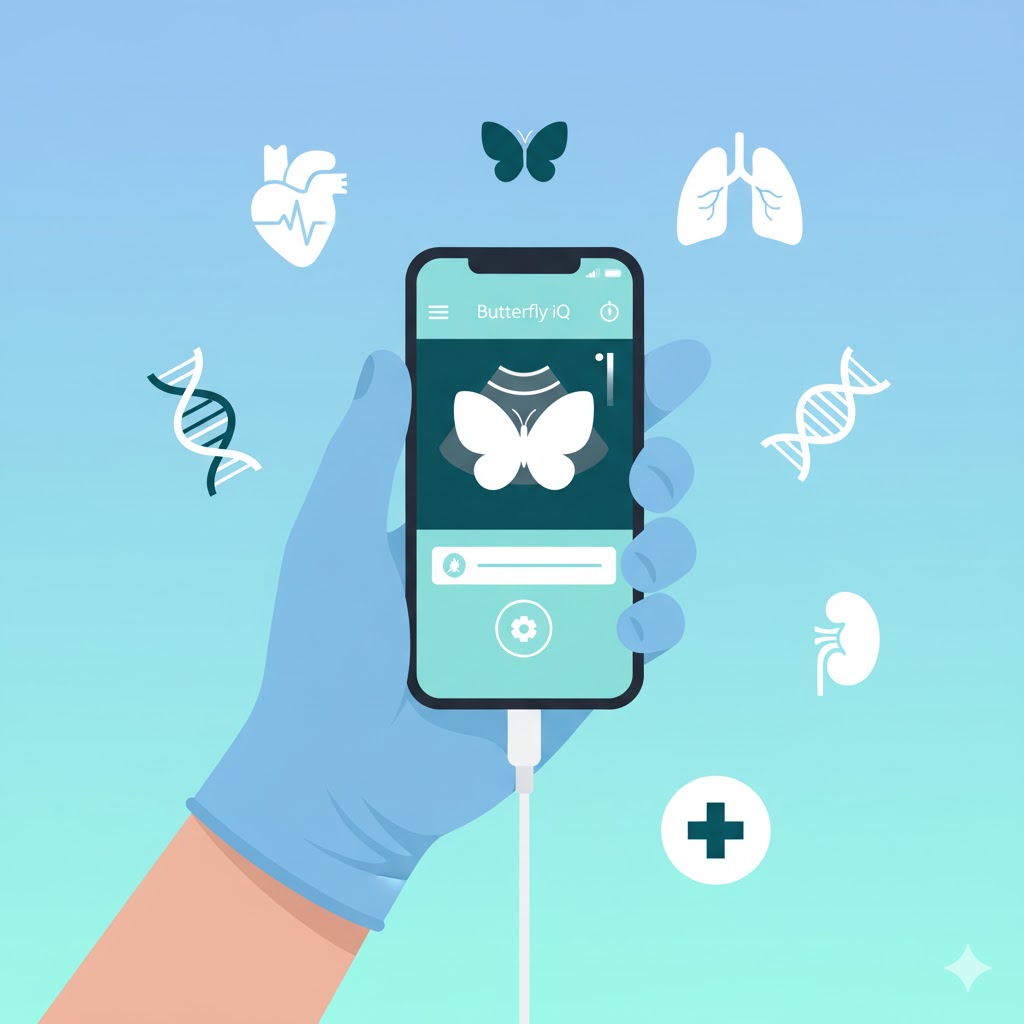The idea of performing an ultrasound exam using a cell phone seemed like science fiction until recently. At the moment, this technology not only exists, but is also redefining the boundaries of diagnostic medicine. However, it is crucial to make a fundamental distinction: we are not talking of entertainment or simulation applications, but Yes of a revolutionary professional medical tool. In that regard, at the heart of this innovation is the Butterfly iQ, a device that transforms a compatible smartphone or tablet into a powerful window into the human body. That's why, this article explores in detail what it is and How the Butterfly iQ portable ultrasound works, a technology that is democratizing access to imaging exams worldwide.
FirstlyForget the apps that promise to "see the baby" as a joke. The Butterfly iQ is actually a point-of-care ultrasound (POCUS) device designed for doctors, nurses, paramedics, and other qualified healthcare professionals. It combines a portable probe that connects directly to your mobile device with a robust app that uses artificial intelligence. Consequently, it offers high-quality images for fast and accurate diagnoses at the bedside, in ambulances or in remote locations. Therefore, understanding its operation is understanding the future of portable medicine.
What is Butterfly iQ and what makes it so different?
The Butterfly iQ isn't just an accessory; it's essentially a complete ultrasound system that fits in your pocket. Its key innovation lies in its proprietary technology, which dramatically differentiates it from traditional ultrasound devices and, of course, from any common app available to the general public.
Butterfly iQ — Ultrasound
Android
The Revolutionary Technology: Ultrasound-on-Chip™
Unlike traditional ultrasound probes, which use piezoelectric crystals to generate sound waves, the Butterfly iQ uses an innovative approach. Specifically, it integrates 9,000 micro-machined sensors on a single silicon chip, similar to the chips found in computers. This technology, called "Ultrasound-on-Chip™," allows a single probe to emulate any type of transducer (linear, curvilinear, or phased array) through software. In other words, with a single device, a healthcare professional can examine any part of the body, from the heart to the lungs, including abdominal and vascular structures, simply by selecting a mode in the app.
It's not an “App”, it's a Regulated Medical Device
It's crucial to emphasize that the Butterfly iQ is a medical device. The accompanying app serves as an interface for controlling the probe and viewing images, but in truth, the probe's hardware does the real work. To use it in Brazil, it needs proper approval from regulatory agencies, such as Anvisa. Furthermore, the company sells the device exclusively to healthcare professionals and institutions, requiring professional registration (such as CRM or COREN) for purchase. Like this, its function is strictly clinical and diagnostic, representing a significant advance in medicine and not a consumer gadget.
Advantages and Clinical Applications of Butterfly iQ
The ability to take ultrasound anywhere opens up a range of possibilities, improving the quality of care and speeding up diagnoses that could previously take hours or days. Next, we explore the main benefits that show How the Butterfly iQ portable ultrasound works in clinical practice.
Extreme Portability and Immediate Diagnosis
The main advantage is, without a doubt, portability. For example, a physician can carry the Butterfly iQ in their lab coat pocket and perform an imaging exam at the bedside, in an emergency, or during a home visit. This eliminates the need to transport an unstable patient to the radiology suite, allowing for faster, more assertive clinical decisions. In trauma situations, a provider can perform a FAST (Focused Assessment with Sonography for Trauma) exam in seconds to detect internal bleeding.
Unparalleled Versatility with a Single Probe
As mentioned earlier, Butterfly iQ technology allows a single probe to do the work of three. With over 20 presets available in the app, the practitioner can instantly switch between exams, such as:
- Cardiac: Assess heart function and look for pericardial effusions.
- Pulmonary: Detect pneumothorax, edema or consolidations.
- Abdominal: Examine organs such as the liver, kidneys, and bladder.
- Vascular: Guide central venous access or assess thrombosis.
- Obstetric: Confirm the presence of a fetal heartbeat in an emergency.
Butterfly iQ — Ultrasound
Android
Democratization and Cost-Benefit
While it's a significant investment, the Butterfly iQ costs a fraction of what a traditional ultrasound machine costs. That, in turn, makes the technology accessible to smaller clinics, private practices, and healthcare systems in developing countries. In the long run, the ability to perform faster diagnoses and avoid more expensive or unnecessary tests generates considerable savings for the entire healthcare system.
How the Butterfly iQ Portable Ultrasound Works: Step by Step
Understanding how the device works in practice helps demystify the technology and understand how it easily integrates into clinical workflow. In fact, the process is intuitive and the developers designed it to be fast.
Step 1: Connecting the Hardware
Firstly, the process begins with the Butterfly iQ+ probe. The professional connects it directly to the charging port of the smartphone or tablet (available with Lightning or USB-C connectors). Interestingly, the mobile device's own battery powers the probe, eliminating the need to charge two things separately.
Step 2: Opening the Software (Application)
Right awayWith the probe connected, the professional opens the Butterfly iQ app. After logging in, the app automatically recognizes the probe and is ready for use. The interface is clean and easy to navigate, displaying what the probe is "seeing" in real time.
Step 3: Selecting the Preset and Performing the Exam
The user then chooses the desired preset from the menu. If examining the heart, they select "Cardiac"; if examining a vascular access, they choose "Vascular." This selection automatically optimizes the image parameters (frequency, depth, gain) for that specific application. After thatWith the gel applied to the patient's skin, the professional positions the probe and performs the exam, viewing high-resolution images on the cell phone screen. They can freeze the image, take measurements, add annotations, and record short videos (clips).
Step 4: Saving, Analyzing, and Sharing in the Cloud
Finally, the professional can save all captured images and videos anonymously and securely to Butterfly Cloud, a platform compliant with healthcare data security standards (HIPAA, GDPR). From the cloud, exams can be easily shared with colleagues for a second opinion, attached to the patient's electronic medical record, or used for teaching and training purposes. This cloud integration is undoubtedly one of the key differentiators, facilitating telemedicine and collaboration. Therefore, the process of How the Butterfly iQ portable ultrasound works goes beyond the examination, encompassing the entire diagnostic workflow.
Situation in Brazil: Anvisa and the Purchasing Process
For a medical device to be marketed and used in Brazil, the National Health Surveillance Agency (Anvisa) must approve it. The Butterfly iQ already has this authorization, which ensures that it meets all the strict safety and efficacy criteria required in the country.
Healthcare professionals and institutions purchase the device through authorized distributors in Brazil. The process is aimed at legal entities (clinics, hospitals) or self-employed healthcare professionals actively registered with their professional associations. Generally, it is necessary to provide the CNPJ or professional registration number to make the purchase, which reinforces its character as a professional tool. Additionally, in addition to the cost of the device, there is a subscription model (membership) that enables access to advanced software features and cloud storage.

Conclusion: A New Era for Diagnostic Imaging
Butterfly iQ is much more than an “ultrasound app.” In reality, it symbolizes a paradigm shift in medicine, where diagnostic imaging becomes more accessible, faster, and smarter. By putting the power of a versatile ultrasound system in the pockets of healthcare professionals, it empowers faster, more informed clinical decisions, which can, ultimately, save lives. Technology demonstrates How the Butterfly iQ portable ultrasound works not just as a tool, but as a catalyst for more equitable and efficient health care. Undoubtedly, the future of ultrasound is portable, and it is already here.





